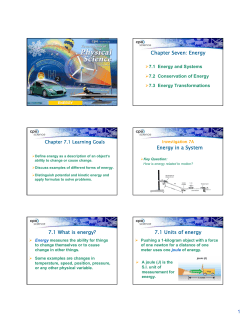
15.1 Energy and Its Forms
15.1 Energy and Its Forms • Avalanches have a great potential for danger, so scientists research when to cause them in order to keep skiers safe. • Energy is the ability to do work. • Energy causes change in – Motion – Sound – Appearance • Work is a transfer of energy. • For example, marathon runners have a “carbload,” or eat pasta the night before the race to be able to run 26.2 miles. • It does not take energy to sit (0 J of work done). Kinetic Energy • Kinetic energy is the energy of motion. • Kinetos means “moving” in Greek. • The kinetic energy of any moving object depends upon its mass and speed. • KE = ½ mv2 • KE = kinetic energy (J) • M = mass (kg) • V = velocity (m/s) Kinetic Energy Problems • The mass of an object is 2 kg. Its velocity is 4 m/s. What is its KE? • KE = ½ mv2 • KE = ½ (2kg)(4 m/s)2 • KE = ½(2)(16) • KE = 1(16) • KE = 16 J KE Problems • The KE of an object is 400 J. Its velocity is 10 m/s. What is its m? • KE = ½ mv2 • 400 = ½ (m)(10 m/s)2 • 400 = ½(m)(100) • 4 = 1/2(m) • m = 8 kg KE Problems • The KE of an object is 81 J. Its mass is 2 kg. What is its velocity? • KE = ½ mv2 • 81 = ½ (2kg) (v)2 • 81 = (1) (v)2 • 811/2 = (v2)1/2 • V = + or – 9 m/s Potential Energy • Potential energy is energy that is stored as a result of position or shape. • Examples are a stretched string, a diver at the end of the board, a car at the top of a roller coaster, etc. • Food is also potential energy (it is stored to be used later) and changes its chemical shape. Gravitational Potential Energy • Gravitational potential energy is potential energy that depends upon an object’s height. • Someone in a roller coaster car at the top of the first hill has no KE, but a large PE (high height). • An object’s gravitational potential energy depends on its mass, its height, and the acceleration due to gravity. Potential Energy Problems • • • • • PE = mgh PE is in J M is in kg G is 10 m/s2 H is in m PE Problems • A 2 kg object is placed atop a 4 m shelf. What is its potential energy? • PE = mgh • PE = (2)(10)(4) • PE = 80 J PE Problems • An object has 90 J of PE and is on a 3 m shelf. What is the object’s mass? • PE = mgh • 90 = (m)(10)(3) • 90 = 30 m • M = 3 kg PE Problems • A 2 kg object has a potential energy of 50 J. What is its height? • PE = mgh • 50 = (2)(10)(h) • 50 = 20 h • 2.5 m = h Elastic Potential Energy • The potential energy of an object that is stretched or compressed is elastic potential energy. • This includes anything that springs, such as stringed instruments (guitars, etc.) and bungee cords. • This also includes anything that bounces, such as a basketball. Forms of Energy • The major forms of energy are mechanical energy, thermal energy, chemical energy, electrical energy, electromagnetic energy, and nuclear energy. • These can be broken down to KE and PE. Mechanical Energy • The energy associated with the motion and position of everyday objects is mechanical energy. • This includes not only machines but also people on the move. • Some mechanical energies come from chemical energy being transformed. Thermal Energy • The total potential and kinetic energy of all the microscopic particles in an object make up its thermal energy. • High temperatures give off light (photons). • Transfer is from hot to cold. • Endothermic- takes in heat • Exothermic- gives off heat Chemical Energy • The energy stored in chemical bonds is chemical energy. • Broken bonds do work. • ATP becomes ADP. • Combustion of gasoline moves cars. Electrical Energy • The energy associated with electric charges is electrical energy. • Electrical forces are used to do work. • Examples are batteries and lightning. • Battery potential is measured in volts (V). Electromagnetic Energy • A form of energy that travels through space in the form of waves is electromagnetic energy. • This includes solar radiation, visible light, and x-rays. • X-rays were given the name because scientists don’t know what they are (x is a variable in Algebra). Nuclear Energy • The energy stored in atomic nuclei is known as nuclear energy. • The strong and weak nuclear forces store an extremely high PE. • Fission releases energy by splitting the nuclei. • Fusion releases energy when less massive nuclei come together. • The sun undergoes fusion of H into He.
© Copyright 2025





















